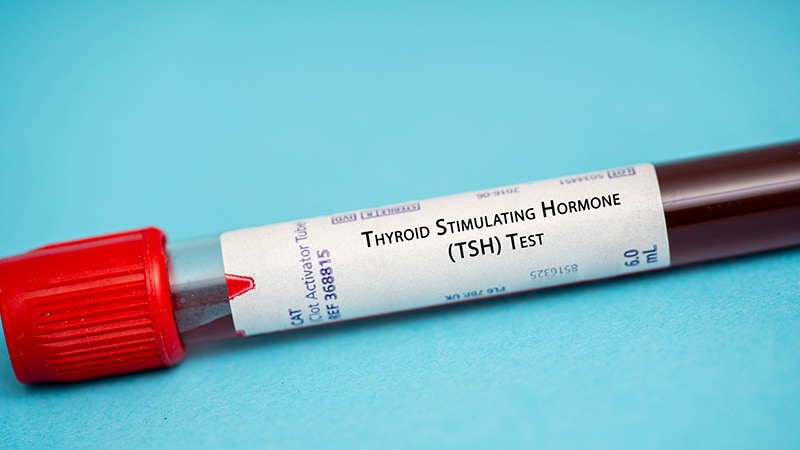Thyroid Test: Seasonal Variation Impact on Overprescribing
Core Concepts
Seasonal variation in TSH levels can lead to overprescribing of levothyroxine, impacting thyroid function testing accuracy.
Abstract
The content discusses how seasonal variation in TSH levels can result in false diagnoses of subclinical hypothyroidism and unnecessary prescriptions of levothyroxine. Key points include:
- TSH levels vary widely throughout the seasons, peaking in winter and decreasing in summer.
- Free thyroxine levels remain stable despite TSH fluctuations.
- Recommendations to retest before prescribing levothyroxine unnecessarily.
- Highlighting the impact of seasonal variation on TSH reference ranges and overprescribing.
- Suggestions to adapt TSH cutoffs based on clinical outcomes and subpopulations.
- Importance of understanding appropriate TSH ranges in specific subpopulations.
- Acknowledgment of the need for joint efforts to address laboratory reference range issues.
Customize Summary
Rewrite with AI
Generate Citations
Translate Source
To Another Language
Generate MindMap
from source content
Visit Source
www.medscape.com
Thyroid Test: Seasonal Variation May Lead to Overprescribing
Stats
"This seasonal variation in TSH could account for between a third to a half of the 90% of all levothyroxine prescriptions that were found to be unnecessary, according to a US study in 2021, El-Khoury adds."
"The upper end of the population they tracked goes from 5.2 [mIU/L] in January to 3.4 [mIU/L] in August."
"Major recent studies have found no benefit of levothyroxine treatment with TSH levels below 7.0-10.0 mIU/L, he said."
Quotes
"If you end up with a mildly elevated TSH result and a normal FT4, try getting retested 2-3 months later to make sure this is not a seasonal artifact or transient increase before prescribing/taking levothyroxine unnecessarily." - Joe M. El-Khoury
"Ensuring that minor abnormalities aren't transient is important prior to initiating medical therapy. With any medical therapy there are possible side effects, along with time, cost, [and] monitoring, all of which can be associated with thyroid hormone replacement." - Trisha Cubb, MD
Key Insights Distilled From
by Miriam E. Tu... at www.medscape.com 04-24-2023
https://www.medscape.com/viewarticle/991095
Deeper Inquiries
How can healthcare providers adapt to seasonal variations in TSH levels to avoid unnecessary prescriptions?
Healthcare providers can adapt to seasonal variations in TSH levels by being aware of the potential impact on thyroid function testing. One approach is to consider the seasonality factor when interpreting TSH results, especially in cases where TSH levels are mildly elevated but FT4 levels remain normal. In such instances, providers can opt to retest patients after a few months to rule out seasonal fluctuations before initiating unnecessary treatment with levothyroxine. This proactive approach can help prevent false diagnoses of subclinical hypothyroidism and unnecessary prescriptions, particularly in cases where the elevated TSH levels may be attributed to seasonal variation rather than an underlying thyroid disorder.
What are the potential implications of using clinical outcome-based treatment cutoffs for thyroid disorders?
Using clinical outcome-based treatment cutoffs for thyroid disorders can have significant implications for patient care and treatment decisions. By shifting the focus from fixed laboratory reference ranges to clinical outcomes, healthcare providers can tailor treatment approaches based on individual patient characteristics and needs. This personalized approach may help avoid unnecessary prescriptions of levothyroxine in cases where the benefits may not outweigh the risks, especially in populations where the evidence does not support treatment below certain TSH levels. Adapting treatment cutoffs based on clinical outcomes can lead to more targeted and effective management of thyroid disorders, ultimately improving patient outcomes and reducing the potential harms associated with overtreatment.
How can the medical community address the challenges posed by seasonal variation in laboratory reference ranges?
Addressing the challenges posed by seasonal variation in laboratory reference ranges requires a collaborative effort within the medical community. One approach is to raise awareness among healthcare providers, professional medical societies, reference laboratories, and assay manufacturers about the impact of seasonal variation on thyroid function testing. By acknowledging the issue and advocating for changes in how reference ranges are established and interpreted, the medical community can work towards developing guidelines that account for seasonal fluctuations in TSH levels. Additionally, conducting further research to generate more generalizable data on the effects of seasonality on thyroid lab results can help inform evidence-based guidelines and practices. Ultimately, by recognizing and addressing the challenges posed by seasonal variation, the medical community can improve the accuracy of thyroid function testing and reduce the likelihood of unnecessary prescriptions and false diagnoses.
0
